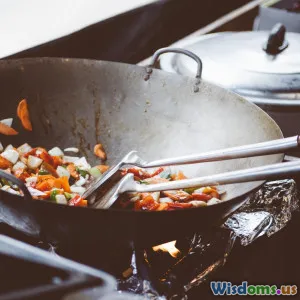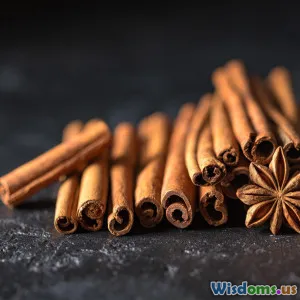
How To Sauté Vegetables Without Burning Them
15 min read Master the art of sautéing vegetables: tips, techniques, and science-backed insights for perfect flavor and texture—without burning a single bite. (0 Reviews)
How To Sauté Vegetables Without Burning Them
Do you dream of savory, vibrant vegetables sizzling in the pan, yet too often end up with charred bits and burned bottoms? You’re not alone! Perfectly sautéed vegetables are a mark of culinary finesse—a symphony of crisp edges, tender interiors, and a surge of fresh flavors. Yet, the fine line between caramelized and carbonized can be frustratingly thin.
Fortunately, mastering the art of sautéing isn’t mysticism—it’s a blend of technique, attention, and science. In this comprehensive guide, we’ll unravel the secrets of sautéing vegetables to perfection: no smoke, no scorches, just beautiful flavors and textures in every bite.
Table of Contents
- Why Sautéing Matters
- Understanding the Science of Sautéing
- Selecting Your Vegetables: Not All Are Equal
- Essential Tools: The Right Pan & Utensils
- Prepping Vegetables for Sauté Success
- Oil Selection: The Foundation of Flavor (And Safety!)
- Temperature Mastery: Heat Is Key
- Technique Spotlight: Stirring, Shaking, and Timing
- Common Mistakes—and How to Dodge Them
- Pro Chef Tips & Real-World Wisdom
- Conclusion: Bringing It All Together
Why Sautéing Matters
Sautéing isn’t just a matter of convenience. It’s a cooking technique that amplifies the flavors, colors, and nutrients of your vegetables—if done right. When you sauté properly, you:
- Intensify sweetness via caramelization.
- Concentrate flavors by removing excess water gently.
- Maximize nutrients, as sautéing preserves vitamins better than some other methods (University of Murcia, 2008).
Yet, for many home cooks, sautéing frequently slides into a rapid race toward burning—leaving bitterness instead of brightness. Let’s investigate why.
Understanding the Science of Sautéing
The secret to effective sautéing lies in controlled, high-heat cooking—using minimal fat to brown and soften ingredients quickly.
This process requires maintaining the balance between these two reactions:
- Caramelization: The browning of vegetable sugars (onions, carrots, bell peppers) occurs at ~320°F (160°C). This creates sweet, complex notes.
- Maillard Reaction: Proteins and sugars interact around 300°F (150°C), lending savory umami flavor and toasty color.
But too much heat, and you skip these delicious reactions—leaping straight to burning. According to food scientist Harold McGee, “If you maintain proper heat and moisture, you get all the flavors without scorching.”
Selecting Your Vegetables: Not All Are Equal
Different vegetables need distinct approaches when sautéing, because of their:
- Moisture content: Zucchini, mushrooms, tomatoes holding more water, require higher heat to evaporate liquids quickly.
- Density: Root vegetables like carrots, potatoes, and beets are denser and need to be sliced thinly or pre-cooked.
- Size and Cut: Evenness is essential for uniform cooking.
Example:
- A small broccoli floret sautés in minutes. A thick chunk burns outside before the inside turns tender.
Tip:
For mixed veggie sautés (e.g., a classic stir-fry), cut vegetables to similar sizes and cook denser types first, adding tender ones later.
Sautéing Times Cheat Sheet:
| Vegetable | Prep | Cooking Time (approx.) |
|---|---|---|
| Mushrooms | Sliced | 6-8 minutes |
| Zucchini | Half-moons, 1/4" | 5-6 minutes |
| Bell Pepper | Strips, 1/2" | 6-7 minutes |
| Carrot | Thin rounds | 7-8 minutes |
| Onion | Sliced | 5-7 minutes |
Essential Tools: The Right Pan & Utensils
Your equipment can make or break your sauté.
- Pan Material Matters:
- Stainless steel delivers crisp voices but requires attentive moisture and oil control.
- Nonstick pans are oxidation bulletproof but don’t brown vegetables as deeply (avoid high heat to preserve coating).
- Cast iron excels in heat retention for higher volumes.
“The most important feature is a pan with a broad, flat surface,” emphasizes chef Samin Nosrat. This ensures max contact with heat and efficient evaporation of moisture.
- Size: Overcrowding = steaming from trapped moisture, not sautéing.
- Utensils: A heat-proof spatula, wooden spoon, and tongs keep you in control.
Prepping Vegetables for Sauté Success
Proper preparation prevents poor (burnt!) performance. Three overlooked factors:
1. Thoroughly Dry Veggies
Rinse your veggies, then dry them thoroughly. Surface water causes excess splattering and uneven cooking. Use clean towels or a salad spinner.
2. Even, Uniform Cuts
No matter the veggie, size consistency means even cooking. This is especially crucial in a mixed sauté (hi, breakfast hash lovers!).
3. Mind the Blanch: Par-Cook If Needed
Heartier vegetables like potatoes and carrots benefit from a short par-cook (boil for 2-5 minutes, then cool) before sautéing. This decreases overall pan time, lessening burning risk.
Example:
Many restaurants par-blanch green beans before finishing them in a hot pan with aromatics—a method that renders perfect snap without charred exteriors.
Oil Selection: The Foundation of Flavor (And Safety!)
Contrary to popular belief, “the more oil, the better” isn’t true for sautéing—too much oil leads to greasy, limp veggies; too little means hotspots and burning.
Choose Your Oil Wisely
- High Smoke Point oils are crucial. Burnt oil = burnt veggies.
- Examples: Avocado oil (520°F), canola oil (400°F), grapeseed oil (420°F), sunflower oil (440°F).
- Olive oil (375°F) is beloved for flavor–but run the risk of smoking if the pan gets too hot.
Pro Tip: Use a neutral, high smoke point oil for the initial sauté, then finish with a drizzle of extra virgin olive oil or butter off the heat for added flavor.
Temperature Mastery: Heat Is Key
The Goldilocks principle reigns supreme: not too hot, not too cold—just right.
How Hot Is Just Right?
- Preheat the pan until a flick of water dances and evaporates instantly; this usually means ~350°F (175°C).
- Add oil after pan is heated to protect the oil from breaking down early.
- Don’t let the oil smoke. Smoke means burning is seconds away. If it does, wipe pan and restart.
Step-by-Step Test:
- Preheat pan for 1-2 minutes on medium-high.
- Glide in oil; swirl to coat base evenly.
- Add veggies in a single layer—listen for a sizzle as they contact the pan.
“The sizzle is your signal—the symphony of flavor has begun!” – Chef Kristen Kish
Technique Spotlight: Stirring, Shaking, and Timing
How you handle the vegetables mid-cook matters as much as how you start.
Stir But Don’t Overcrowd
- Allow vegetables to sit, undisturbed, for 30–60 seconds to develop color.
- Stir or toss gently to rotate surface contact.
- Constant agitation prevents even browning; minimal stirring is best until browning develops.
Avoid Overcrowding
Too many veggies = steam bath. Work in batches if needed.
The Role of Seasoning
Season lightly with salt partway through cooking. Salt initially can pull too much water out, leading to premature steaming. Black pepper, herbs, and finishing touches adore the residual heat after removal from the pan.
Example Timing—Classic Sautéed Medley:
- Sauté sliced onions for 3 minutes.
- Add carrots and continue sautéing 4 more minutes.
- Toss in bell peppers and zucchini, finish sauté for 3-4 minutes more.
Common Mistakes—and How to Dodge Them
1. Cold Pan Syndrome
Adding veggies to an unheated pan means they soak up oil and become greasy, not golden brown.
2. Letting Oil Smoke
Burned oil imparts acrid, unpleasant flavors and makes burning almost inevitable. Start over if this happens.
3. Overcrowding
This causes steaming. Two smaller, separate batches are better than a mass of soggy, burnt veggies.
4. Neglecting the Pan
Sautéing is an active process—don’t step away. Watch cues: color, aroma, sound.
5. Cooking Everything at Once
Layering vegetable additions by density and moisture delivers perfectly cooked, never scorched results.
Pro Chef Tips & Real-World Wisdom
Mindful Cooking: Stay Present
Sautéing rewards noticing the small things: is there a faint change in the vegetable’s aroma or color? Listen for shifts in sizzle—the song of sauté.
Experiment With Flavors
- Add aromatics (garlic, ginger, shallots) for the final minute to avoid burning.
- Splash with a teaspoon of soy sauce, balsamic vinegar, or fresh lemon juice off the heat for brightness.
- Finish with fresh herbs or a pat of butter after you’ve killed the heat.
Real-World Insight:
A 2018 study in Food Science & Nutrition found that, compared to boiling, vegetables sautéed over controlled medium-high heat in high-smoke point oil retained more carotenoids (nutrients that preserve vibrant color and provide antioxidants) and tasted sweeter.
Quotes From The Pros:
- “Perfect sautéing is more about attention than technique.” — Julia Child
- “Don’t crowd the pan!” — Gordon Ramsay’s relentless sautéing mantra
Conclusion: Bringing It All Together
Sautéing vegetables without burning them is as much about intentionality as skill; understanding your ingredients, pan, and heat turns an everyday task into an extraordinary experience.
- Choose and cut your vegetables wisely—it matters!
- Use the right tools and oils, paying attention to smoke points and technique.
- Keep your eye on the signs: sizzle, aroma, and browning.
- Practice mindful, attentive cooking—your tastebuds will thank you!
Ready to put theory into practice? Grab your favorite pan, prep your veggies, and chase that perfect pan-sizzle. With these tips, you’ll say goodbye to burnt bits and hello to a world of flavorful, perfectly sautéed goodness every single time.
References
- McGee, Harold. On Food and Cooking. Scribner, 2004.
- University of Murcia, “Influence of Cooking on the Vitamin Content of Vegetables,” Food Chemistry Journal, 2008.
- Food Science & Nutrition, "Comparative Study of Boiling and Sautéing on Nutrient Retention," 2018.
- Chef Samin Nosrat, author of Salt, Fat, Acid, Heat.
- Chef Kristen Kish, TV host and culinary instructor.
Quick Sauté Recipe to Try:
Basic Sautéed Vegetable Medley
Ingredients:
- 1 bell pepper, sliced
- 1 zucchini, half-mooned
- 1 small onion, sliced thin
- 1 cup mushrooms, sliced
- 2 tbsp avocado oil
- Salt and pepper to taste
- Optional: 1 tsp chopped garlic, chiffonade fresh basil for garnish
Instructions:
- Dry all cut veggies thoroughly.
- Heat a large, flat pan over medium-high for 2 minutes.
- Add oil. When shimmery, add onions and mushrooms; sauté 3 min.
- Add bell pepper and zucchini. Sauté, stirring every 45 sec, for 4–5 min, until tender, not burned.
- Add garlic for the last minute, if using. Season off heat, scatter basil, and serve.
Enjoy your vibrant veggies—burnt no more!
Rate the Post
User Reviews
Other posts in Nutrition
Popular Posts
















